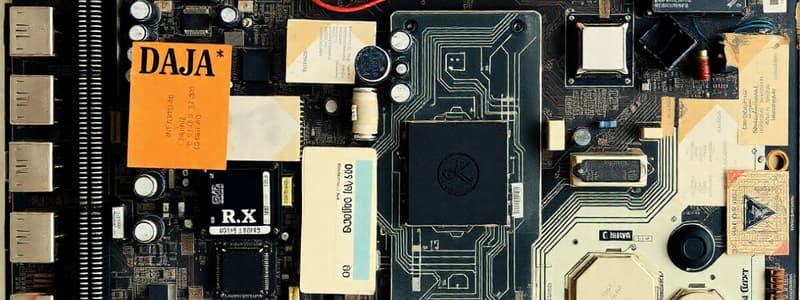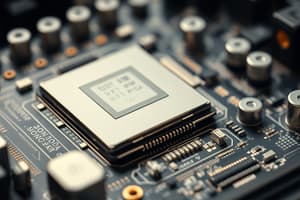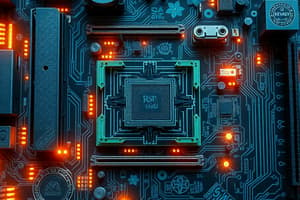Podcast
Questions and Answers
What characterizes a non-integrated motherboard?
What characterizes a non-integrated motherboard?
- Allowing for upgrades like video card replacement (correct)
- Having a limited number of PCI slots
- Incompatibility with modern processors
- The inability to upgrade components
Which factor differentiates micro-ATX motherboards from ATX motherboards?
Which factor differentiates micro-ATX motherboards from ATX motherboards?
- Micro-ATX is larger than ATX
- Micro-ATX is designed for 32 bit processors only
- Micro-ATX has a reduced physical size (correct)
- Micro-ATX supports more I/O slots
When was the ATX motherboard introduced?
When was the ATX motherboard introduced?
- Mid 90s (correct)
- Early 80s
- Late 90s
- Early 2000s
What is a key feature of AT motherboards?
What is a key feature of AT motherboards?
Which of the following companies is not a manufacturer of motherboards?
Which of the following companies is not a manufacturer of motherboards?
What advantage do I/O connectors provide on a motherboard?
What advantage do I/O connectors provide on a motherboard?
What type of computer architecture do modern motherboards generally support?
What type of computer architecture do modern motherboards generally support?
Which of the following is a characteristic of USB ports?
Which of the following is a characteristic of USB ports?
What is the primary role of the motherboard in a computer?
What is the primary role of the motherboard in a computer?
Which statement correctly defines an expansion slot?
Which statement correctly defines an expansion slot?
What does the term 'Plug and Play' refer to in computer components?
What does the term 'Plug and Play' refer to in computer components?
What identifies a PC card?
What identifies a PC card?
What is the function of the chipset on the motherboard?
What is the function of the chipset on the motherboard?
Which feature distinguishes an integrated motherboard from a non-integrated motherboard?
Which feature distinguishes an integrated motherboard from a non-integrated motherboard?
Which of the following is considered a type of expansion card?
Which of the following is considered a type of expansion card?
What two components combined form the chipset on a motherboard?
What two components combined form the chipset on a motherboard?
Flashcards are hidden until you start studying
Study Notes
The Motherboard
- The motherboard is the central hub that connects all essential computer components, being the main printed circuit board (PCB).
- Also known as the system board or main board, it incorporates chips, integrated circuits, and transistors.
- Functions as a "parent" board, providing connectors for expansion cards, memory modules, and the processor.
Expansion Slots and Cards
- Expansion slots are sockets on the motherboard where circuit boards (expansion cards) can be inserted.
- Plug and Play technology allows automatic configuration of newly installed cards and devices.
- PC cards are credit card-sized devices used in laptops to enhance capabilities, including modems and additional memory; standardized by PCMCIA.
- Flash memory cards augment memory in handheld computers, digital music players, and mobile phones.
The Chipset
- The chipset coordinates data transfers among computer components like the processor and memory.
- Comprises the Northbridge and Southbridge circuits, ensuring efficient communication.
- Selection of a motherboard with a modern chipset is crucial for future upgradeability.
Types of Motherboards by Device Support
- Integrated motherboards feature multiple components built into the board, such as the CPU, video card, and sound card.
- Non-integrated motherboards utilize installable components and usually have several PCI expansion slots for upgrades; they are becoming obsolete.
Types of Motherboards by Form Factor
- AT Motherboard: Measures around several hundred millimeters and cannot fit in mini desktops; succeeded by Baby AT.
- ATX Motherboard: Introduced by Intel in the mid-90s, it improved layout and integration compared to the AT motherboard.
- Micro-ATX: Maintains ATX benefits while minimizing overall size and reducing supported I/O slots.
Manufacturers of Motherboards
- Various configurations and sizes are available, supporting 32-bit (obsolete) and 64-bit processors and operating systems.
- Notable manufacturers include ASUS, Intel, and MSI.
Ports and Connectors
- Ports connect external devices to the system unit, facilitating communication and operation.
- Common connectors include USB, serial ports, parallel ports, and others for keyboards, mice, monitors, printers, and speakers.
- USB (Universal Serial Bus) ports support a wide range of devices and simplify connections.
Studying That Suits You
Use AI to generate personalized quizzes and flashcards to suit your learning preferences.




